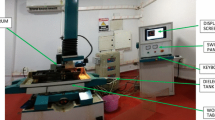Abstract
In this study, an attempt has been made to model electrode wear (EW) and recast layer thickness (WLT) through response surface methodology (RSM) in a die-sinking EDM process. A central composite rotatable design (CCRD) involving three variables with five levels has been employed to establish a mathematical model between input parameters and responses. Pulse on-time, pulse off-time and pulse current were changed during the tests based on the CCRD. The results of analysis of variance (ANOVA) indicated that the proposed mathematical models obtained can adequately describe the performances within the limits of factors being studied. The experimental and predicted values were in a good agreement.
Similar content being viewed by others
References
Shu KM, Tu GC (2003) Study of electrical discharge grinding using metal matrix composite electrode. Int J Mach Tools Manuf 43:845–854
Guu YH (2005) AFM surface imaging of AISI D2 tool steel machined by EDM process. Appl Surf Sci 242:245–250
Ramasawmy H, Blunt L, Rajurkar KP (2005) Investigation of the relationship between the white layer thickness and 3D surface texture parameters in the die-sinking EDM process. Precis Eng 29:479–490
Tsai YY, Masuzawa T (2004) An index to evaluate the wear resistance of the electrode in micro-EDM. J Mater Process Technol 149(1–3):304–309
Zarepour H, Tehrani AF, Karimi D, Amini S (in press) Statistical analysis on electrode wear in EDM of tool steel DIN 1.2714 used in forging dies. J Mater Process Technol, Article in press
Marafona J (2007) Black layer characterization and electrode wear ratio in electrical discharge machining. J Mater Process Technol 184:27–31
Luis CJ, Puertas I, Villa G (2005) Material removal rate and electrode wear study on the EDM of silicon carbide. J Mater Process Technol 164–165:889–896
Puertas I, Luis CJ, Alvares L (2004) Analysis of the influence of EDM parameters on surface quality, MRR and EW of WC-Co. J Mater Process Technol 153–154:1026–1032
Liu CC (2003) Microstructure and tool electrode erosion in EDMed of TiN/Si3N4 composites. Mater Sci Eng A 363:221–227
Lee HT, Tai TY (2003) Relationship between EDM parameters and surface crack formation. J Mater Process Technol 142:676–683
Rebelo JC, Morao DA, Kramer D, Lebrun JL (1998) Influence of EDM pulse energy on the surface integrity of martensitic steels. J Mater Process Technol 6:84–90
Lee HT, Yur JP (2000) Characteristic analysis of EDMed surfaces using the Taguchi approach. J Mater Manuf Proc 15:781–806
Kruth JP, Van HJ, Stevans L (1995) Microstructural investigation and metallographic analysis of the white layer of a surface machined by electro discharge machining. Proceedings of the conference ISEM – XI, 849–62
Lin BT, Jean MD, Chou JH (2007) Using response surface methodology for optimizing deposited partially stabilized zirconia in plasma spraying. Appl Surf Sci 253:3254–3262
Aslan N (2007) Application of response surface methodology and central composite rotatable design for modelling the influence some operating parameters of a Multi-Gravity Separator for coal cleaning. Fuel 86:769–776
Chiang KT, Chang FP, Tsai DC (2007) Modeling and analysis of the resolidified layer of SG cast iron in the EDM process through response surface methodology. J Mater Process Technol 182:525–533
Palanikumar K (in press) Modeling and analysis for surface roughness in machining glass fibre reinforced plastics using response surface methodology. Mater Des, Article in Press.
Lee LC, Lim LC, Narayanan V, Venkatesh C (1988) Quantification of surface damage of tool steels after EDM. Int J Mach Tools Manuf 28:359–372
Hewidy MS, El–Taweel TA, El–Safty MF (2005) Modeling the machining parameters of wire electrical discharge machining of Inconel 601 using RSM. J Mater Process Technol 169:328–336
Bhattacharyya B, Gangopadhyay S, Sarkar BR (in press) Modeling and analysis of EDMed job’s surface integrity. J Mater Process Technol, Accepted Manuscript
Napier-Munn TJ (2000) The central composite rotatable design. JKMRC, The University of Queensland Brisbane, Australia, pp 1–9
Palanikumar K, Kartikeyan R (2006) Optimal machining conditions for turning of particulate metal matrix composites using Taguchi and response surface methodologies. Mach Sci Technol 10:417–433
Author information
Authors and Affiliations
Corresponding author
Rights and permissions
About this article
Cite this article
Çaydaş, U., Hasçalik, A. Modeling and analysis of electrode wear and white layer thickness in die-sinking EDM process through response surface methodology. Int J Adv Manuf Technol 38, 1148–1156 (2008). https://doi.org/10.1007/s00170-007-1162-1
Received:
Revised:
Accepted:
Published:
Issue Date:
DOI: https://doi.org/10.1007/s00170-007-1162-1




